Proposed Resolution – Draft V June 2012
Fort Ord’s Ongoing Toxic Cleanup Tragedy
Documented Failures of Fort Ord’s Superfund Cleanup and Request for Legislative Hearings and Action.
by California EPA’s Fort Ord Community Advisory Group (FOCAG)
Subtitle: “The Dangerous Costs of Military Base Toxic Cleanup When Legal Oversight and Accountability are Prohibited by SuperFund Law(1) and Replaced with Bureaucratic Public Relations.”
* Summary
To purportedly clean up Fort Ord, more than half a Billion dollars(2) has been spent since the 1994 closure, however the second largest US-Army base ever closed(3) remains a dangerous and toxic mess, and the cleanup itself is harming many residents.
After more than 70 years of military operations where billions of pounds of ammunition, mortars and bombs were used, Fort Ord was closed in 1994. The US-Army left the base “highly and widely contaminated with toxic materials”
1) Toxic Lead Dust from bullets covers huge areas of sand including the four miles of beach rifle training ranges which is now the Fort Ord Dunes California State Park where children and infants play with no protection or warning,
2) Unexploded Ordnance (UXO) — (including ammunition, mortars and bombs) spread across more than 10,000 acres of impact ranges, much of which is being released for development, and
3) Leaking Unlined Landfills – TriChloroEthelyene and Carbon TetraChloride into ground water under residential areas in the City of Marina, some detected in drinking water wells; and harmful landfill gases are leaking into the air next to California State University, Monterey Bay and its student housing.
This contamination put Fort Ord on the Superfund list, then because it was so highly and widely toxic it was put on the short list called the National Priorities List, a subset of some 1,200 of the most contaminated Superfund sites. The entire former Fort Ord facility was listed “fenceline to fenceline”; all 28,000 acres.
The following details describe conditions today, how all of these problems remain in 2012 — after the half Billion dollar so-called “clean-up.”
* Concerns and Better Alternatives Systematically Ignored
Since the superficial “clean-up” began, all government agencies with direct authority (US Army, BRAC, US-EPA, California-EPA and now FORA) have willfully and systematically ignored —
1) Legitimate concerns about deadly and dangerous cleanup caused problems such as the intentional but out-of-control wildland burning that has repeatedly fumigated nearby cities, and
2) Better, more effective, safer and cheaper Alternatives such as locating unexploded ordnance (UXO) with helicopter magnetometers.
Despite those serious concerns having been explained and documented respectfully, clearly and repeatedly by other government agencies, world class medical and environmental cleanup experts, and some highly informed public citizens — we can find no detectable or meaningful improvement in any of the cleanup procedures.
This superficial “clean-up” is, and will continue, harming potentially thousands of current residents, particularly their children and infants, employees, students and recreational visitors. High-pressure to develop housing, commercial and recreational areas on this former Army Base could cause those developments to get directly affected by the remaining air and water borne toxics, and millions of pounds of remaining subsurface ammunition and weapons (UXO) that can explode at a slight touch, or for no apparent reason.
This is our overview of the most serious problems needing dramatic, urgent and genuine corrective actions which we have found cannot occur without congressional and legislative hearings and legislative improvements.
* Lead Dust(4) Threatens Children:
The new 2009 Fort Ord Beach Park, used as Firing Ranges for 77 years, remains widely, and in some areas heavily contaminated with toxic lead dust and lead in other forms, because only the “hottest” spots were treated.
Almost ALL – about 96% of the area where lead was used and found, the beach weapons area, had no lead cleanup at all.(5)
This lead dust threatens the health of children and infants who will use the Park. Lead dust will continue to threaten the health of those living or working downwind of the roughly three mile long beach park. This is essentially all of former Fort Ord now in use, especially areas close to the beach, including thousands of students attending California State University at Monterey Bay and residents of Marina and Seaside.
* Toxics in Drinking Water:
Toxic TriChloroEthelyene (TCE – cancer causing) and Carbon TetraChloride plumes have spread widely, now contaminating ground water under Fort Ord and Marina.6 They have been detected in drinking water wells #29 and #30 of Marina Coast Water District, and threaten to contaminate Monterey Bay6.
Toxic fluids leaked into groundwater in four areas.
1) Fritsche Field Army airport,
2) the train depot where fuel was transferred,
3) the vehicle cleaning area near 12th street gate, and the
4) several landfills.
* Intentional Fires Threaten Homes and Health:
The intentional burning of Fort Ord’s wild lands has roared out of control in almost every case, most significantly in 1997, 1998 and October 2003 provoking large daily newspaper headline “Ord Fire Fuels Anger.”
The surface clearance of unexploded ammunitions by wild land burning is impossible to control by firefighters on the ground or in low flying aircraft because of exploding munitions that will “with 100% certainty fly 1,000 yards and start secondary fires.” (Former Fort Ord EE/CA pg 4-12)
Flames from the out-of-control burns have directly threatened the lives and homes of nearby residents and firefighters, and the smoke has harmed thousands with breathing difficulties as far as Carmel, Pebble Beach, Carmel Valley and down the agricultural Salinas Valley to Greenfield – some 40 miles away. The burning forced prosecution by the Monterey Bay Regional Air Pollution District.
* Unexploded Ammunition (UXO) Left in Development areas:
Areas released for public use and unrestricted private development (e.g. homes and businesses) still contain dangerous live munitions, deeply buried munitions, non-metallic munitions, extra-toxic practice munitions and chemical warfare materials. Depleted uranium may remain in former weapons training areas.
Some dangerous live munitions tend to migrate downhill gravitating to stream beds, washes and trails where bicycling, hiking and horse riding is rapidly increasing.
Amounts remaining are unknown, but could be very large because of deliberately myopic analysis and methods. For example there are over 200 known ammunition components , but the “clean up” has ignored more than three quarters of those chemicals, and stopped looking for some of the most harmful such as perchlorate.
* Landfill Toxic Gas and Water Releases Near Student Homes:
The several Fort Ord Landfills are leaking out of the top and bottom. The landfills have top liners, but no bottom linings allowing the toxics to easily leak into the groundwater.
Toxic landfill gases combined with methane, built up inside the top liners have grown room-sized blisters and leaked. The landfills have apparently leaked these potentially toxic gases into Fort Ord’s air just upwind of and immediately adjacent to the California State University at Monterey Bay housing and campus.
* Systematic Ignoring, Hiding, “Losing” and Refusing to Disclose Vital Cleanup Information (7):
Hiding Vital Information: The Army employs a paper-based “smoke screen” called “Steganography” to hide vital information.
“Steganography is the art and science of writing hidden messages in such a way that no one, apart from the sender and intended recipient, suspects the existence of the message, a form of security through obscurity.”
The Army does this by flooding the public with thousands of trivial documents with highly technical names and language and burying the vital information in a few of them.
Losing Vital Information: Cleanup documents since about 2007 have omitted vital information on former ranges and large amounts of discovered munitions.
By creating this censored and now misleading new administrative record, former range / training areas are being mis-represented as safe when in reality they are highly hazardous with a high risk of occurring.
Refusing Vital Information: FOCAG has formally requested simple documents, sometimes years ago (e.g. beach area lead cleanup maps) that are never produced; or if after a long delay they do show up – they are, at best, unclear – even to technical experts in that field.
* Willful Persistent Avoidance of Expert Concerns and Better Alternatives:
Hundreds, more likely thousands, of serious reasonable concerns in formal comments over the past decade have been presented by highly trained experts, public interest agencies, public interest non-profit groups, public interest groups created specific to the failing Fort Ord Cleanup, highly informed public citizens, and the general public in writing and at dozens and dozens, more likely hundreds, of meetings.
Yet very few, if any, of the tens of thousands of “cleanup” actions has changed in any substantial way as a result of the serious concerns, unless the agencies were forced to do so by litigation that does not directly affect Superfund law.
* Better Alternatives Exist Yet Are Ignored:
Alternatives and “best available science and engineering” methods exist which are safer, more thorough, typically cheaper and almost always far more cost-effective for each “cleanup” facet, and would be illuminated with an Environmental Impact Statement (EIS). However, the US-ARMY, the US-EPA and other agencies persistently fight against preparing an EIS.
* Permanent Danger Trend – with EPA Oversight Fully Blocked
It is this body’s opinion that this systematic failure, this enormous waste of money and these serious, and several potentially deadly and expensive problems, are in large part because Court oversight is almost completely blocked by Superfund / CERCLA federal law.
One point that needs to be emphasized is that any litigation between US-EPA and the Department of Defense results in a conflict of interest, because they both have the same legal representation, the US Department of Justice. Therefore the EPA has no independent legal force to get the Department of Defense to comply with cleanup directives as they could a commercial polluter.
Worse, the State of California could force compliance, but the State of California did not have the staff or budget for such an endeavor. So the Department of Defense has funded the State of California’s effort which basically poses another conflict of interest.
Also under current law the Department of Defense is exempt from EPA regulations and other environmental laws when it comes to matters of national defense.
These three legal problems fully protect Department of Defense from having to do any meaningful cleanup of a SuperFund site. If DoD agrees to do a cleanup they can do it as recklessly as they want – with no concern about actual oversight from any other agency. That is exactly the situation we find at Fort Ord.
Since FOCAG as a body, and its members as individuals, have spent a total of decades of extraordinary and expert efforts to evoke a reasonable response from all accountable Federal and state agencies, and finding no meaningful improvements, we have now reached the carefully considered belief, based on file cabinets filled with evidence and attending hundreds of meetings, that with current trends and oversight Fort Ord will remain a toxic and dangerous place to live, work or visit and the wildland burning will continue to threaten existing residents’ lives, health and property.
* Congressional Review Needed
Therefore we now respectfully request that the US Congress and Senate, and the California Senate and Legislature immediately hold hearings on this continuing disaster before further grave and irreversible harm is done.
Adopted _______________________
Signed by,
Michael Weaver, FOCAG Co-Chair
Vienna Merritt-Moore, FOCAG Co-Chair
David Dilworth, FOCAG member
Dan O’Brien, FOCAG member
Richard Bailey, FOCAG member
Lance Houston, FOCAG member
for the California EPA’s Fort Ord Community Advisory Group
Notes and References —
1. Superfund law prohibits litigation until a Superfund site “cleanup” is ambiguously “complete.”
While this is likely a good idea when the polluter is a private business, when the EPA is charged with oversight of the ARMY, a sister agency, it allows avoidance of genuine cleanup and instead pays for worthless and harmful activities.
This allows agencies to use harmful “clean up” methods that cause serious environmental impacts and ignore evaluating alternatives. It also allows agencies to never decide the cleanup is complete – therefore preventing any litigation on the actual harms – essentially forever.
For example Superfund blocks requiring NEPA analysis in an Environmental Impact Statement for the wild land burning, even though the fire and smoke from this part of the “clean-up” is causing widespread, demonstrable harm to neighboring communities. There is no requirement that US-EPA ever decide a “cleanup” is complete thus permanently excluding agencies from facing litigation that would require a genuine cleanup.
While prohibiting litigation until a cleanup is complete may be a good way to expedite a non-governmental cleanup, when the polluter is a sister federal agency to US-EPA as the US-ARMY is in this case – the Superfund prohibition blocks genuine environmental impact analysis and examination of best available methods and less costly alternatives.
2. Costs: “More than $500 Million” US-ARMY’s Melissa Broadston, FOCAG Meeting August 2009. (It remains unclear if this is for both SuperFund cleanup and Munitions UXO cleanup.)
3. Fort Ord was 28,000 acres. Fort McLleland closed 40,000 acres.
4. Lead: Lead is often the most toxic of ATSDR’s “20 most hazardous toxics“, Lead causes Cancer (US Dept of Health & Human Services, Feb 2005), Lead is a Cumulative Poison (Sax’s Properties of Dangerous Materials) Lead causes Irreversible Damage (263 J. American Medical Assoc 790-91),
Lead: “… small areas of high bullet density and elevated lead concentrations may still exist onsite…” (pg 3) “Lead was detected in discrete samples at this location at concentrations ranging from 49.5 mg/kg to 13,500 mg/kg” (pg 6) – Post-Remediation Health Risk Assessment (PRHRA) and Post-Remediation Ecological Risk Assessment (PRERA) 2007.
5. ATSDR’s website claims the beach ranges pose “No apparent public health hazard” even though they admit 96% of the beach weapons area had no lead cleanup at all. These are areas “moderately” and “lightly” contaminated with lead (“moderate” areas had a mean of 256 ppm, and up to 32,600 ppm). (US-EPA website)
6. Groundwater contamination: “On-site ground water is contaminated with volatile organic compounds (VOCs). One plume near Marina has migrated offsite.” Other leaking Fort Ord VOCs include Benzene (cancer causing), Chloroform (cancer causing), Perchlorethylene (PCE), and MethylEthylKetone (MEK – inhaling large doses can cause birth defects). (US-EPA Website)
7. “there are specific provisions under Superfund Law prohibiting knowingly destroying, concealing, erasing, mutilating, falsifying or otherwise rendering unavailable records or otherwise rendering unavailable records required by EPA regulations to be kept for any hazardous substance storage facility.
RCRA prohibits knowingly destroying, altering a manifest or other document “required to be maintained … for purposes of compliance with regulations.”
Further Reading:
New Battle on Vieques, Over Navy’s Cleanup of Munitions, by Mireya Navarro, 2009
Superfund Reference, New York Times
Not So Super Superfund, New York Times, 1994
The Return of Superfund, New York Times, 2010
Burn Plan Comments on the proposed RI/FS (Remedial Investigation and Feasibility Study), 2002
Spreckels School District Resolution Against Fort Ord Burning
Consultant analysis and comments on the Remedial Investigation/Feasibility Study (RI/FS)
HOPE: “Our Local Man-Made Disaster – Why Is Fort Ord Burning so Harmful?”
Central Coast Alliance for Health (Chaired at the time by Monterey County Supervisor Edith Johnsen) Unanimous 2003 Resolution Opposing the Burning of Fort Ord until a Health Analysis is conducted of the burning.

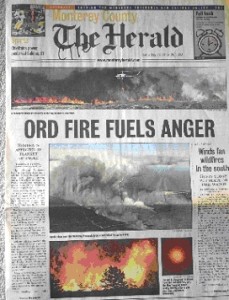
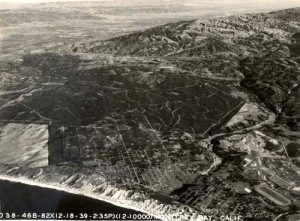
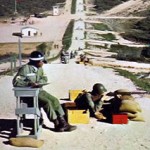
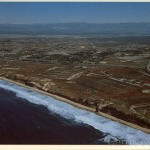
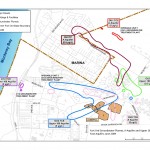
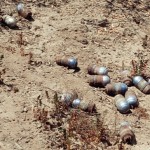
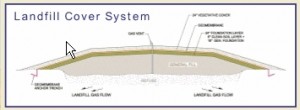


Residents of CA need to replace ALL their elected officials from the Gov. to local, period.
Thank you for informing the public. This is important information for anyone who lives or works in Marina.
Trichloroethylene is one of the major components of the toxic groundwater plumes that underlie the areas surrounding and beneath the City of Marina and the University of California Monterey Bay campus. The source of the chemical is the non lined landfill found on Ft Ord. This dangerous chemical is about to be added to those already included in California Proposition 65 as follows:
By Carolyn Whetzel
Nov. 29 –California’s Office of Environmental Health Hazard Assessment has announced plans to add trichloroethylene to the list of reproductive toxicants maintained under Proposition 65.
In a Nov. 27 notice of intent, the agency proposed listing the volatile organic compound based on U.S. Environmental Protection Agency findings that trichloroethylene (CAS No. 79-01-06) caused male reproductive toxicity and developmental toxicity in laboratory animals.
Under the Safe Drinking Water and Toxic Enforcement Act of 1986, better known as Proposition 65, the state must maintain a list of chemicals known to cause cancer, birth defects or reproductive toxicity. Businesses must provide clear warnings whenever the public is exposed to an unsafe level of a listed substance.
TCE is used as an industrial solvent and is found in several consumer products, including paint removers and adhesives.
.
Was it ever determined if the hazardous materials at Fort Ord were harmful to soldiers stationed there in the 70’s?
Thank you for your question Richard.
I don’t know of any study of the harm to soldiers in the 1970s, or any other time period.
Nevertheless, the toxic plume from the liquids used to wash vehicles (e.g. tanks, trucks and aircraft) near Ft Ord’s Fritche airfield has infiltrated Ft Ord’s main drinking water aquifers.
The firing ranges out near the ocean were thick with bullet lead degraded into dust that blew everywhere on the Army base. Lead is intensely toxic.
And I would not have wanted to be anywhere near downwind of the flammable weapons (magnesium flares).
Maybe someone else knows of a report that can help you better.
I too want to know Richard. For my husband has a Blood cancer.
He was stationed there is the mid 80’s and no one in his family has cancer.
could it be from the water. He said he consumed a lot of water in two years there.
So we have filed papers with our VA to try and get answers.
Thanks Tracy
What did the VA have to say? I was there in the early 70s.
I to was there in the early 70s Tracy if you would let me know what they had to say. I just now found out about this issue.
I’d like to know too. I was there in 71-72.
I’d like to know too . Stationed there Jan 85′ to Aug 88′
I was there in 69, and have had reproductive problems and it seems my biological development slowed down; I amazingly look almost 20 years younger than I am, which confuses people and me. I am disease ridden for no known reason. The time I spent there is a great memory, but the report about toxic pollution is a real bummer.